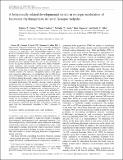Files in this item
A behaviorally related developmental switch in nitrergic modulation of locomotor rhythmogenesis in larval Xenopus tadpoles
Item metadata
| dc.contributor.author | Currie, Stephen Paul | |
| dc.contributor.author | Combes, Denis | |
| dc.contributor.author | Scott, Nicholas William | |
| dc.contributor.author | Simmers, John | |
| dc.contributor.author | Sillar, Keith Thomas | |
| dc.date.accessioned | 2016-04-05T13:30:04Z | |
| dc.date.available | 2016-04-05T13:30:04Z | |
| dc.date.issued | 2016-03 | |
| dc.identifier | 240276946 | |
| dc.identifier | 6afa1735-38d4-4e99-b185-d1786b20a0bb | |
| dc.identifier | 84984856736 | |
| dc.identifier | 000376057400025 | |
| dc.identifier.citation | Currie , S P , Combes , D , Scott , N W , Simmers , J & Sillar , K T 2016 , ' A behaviorally related developmental switch in nitrergic modulation of locomotor rhythmogenesis in larval Xenopus tadpoles ' , Journal of Neurophysiology , vol. 115 , no. 3 , pp. 1446-1457 . https://doi.org/10.1152/jn.00283.2015 | en |
| dc.identifier.issn | 0022-3077 | |
| dc.identifier.other | ORCID: /0000-0003-0171-3814/work/64393761 | |
| dc.identifier.uri | https://hdl.handle.net/10023/8559 | |
| dc.description | Supported by PICS (Projet International de Coopération Scientifique) of the French CNRS and a LabEx BRAIN Visiting Professorship to KTS. SPC was a BBSRC research student. NWS was an MPhil student supported in part by the E & RS Research Fund of the University of St Andrews. | en |
| dc.description.abstract | Locomotor control requires functional flexibility to support an animal's full behavioral repertoire. This flexibility is partly endowed by neuromodulators, allowing neural networks to generate a range of motor output configurations. In hatchling Xenopus tadpoles, before the onset of free-swimming behavior, the gaseous modulator nitric oxide (NO) inhibits locomotor output, shortening swim episodes and decreasing swim cycle frequency. While populations of nitrergic neurons are already present in the tadpole's brain stem at hatching, neurons positive for the NO-synthetic enzyme, NO synthase, subsequently appear in the spinal cord, suggesting additional as yet unidentified roles for NO during larval development. Here, we first describe the expression of locomotor behavior during the animal's change from an early sessile to a later free-swimming lifestyle and then compare the effects of NO throughout tadpole development. We identify a discrete switch in nitrergic modulation from net inhibition to overall excitation, coincident with the transition to free-swimming locomotion. Additionally, we show in isolated brain stem-spinal cord preparations of older larvae that NO's excitatory effects are manifested as an increase in the probability of spontaneous swim episode occurrence, as found previously for the neurotransmitter dopamine, but that these effects are mediated within the brain stem. Moreover, while the effects of NO and dopamine are similar, the two modulators act in parallel rather than NO operating serially by modulating dopaminergic signaling. Finally, NO's activation of neurons in the brain stem also leads to the release of NO in the spinal cord that subsequently contributes to NO's facilitation of swimming. | |
| dc.format.extent | 999256 | |
| dc.language.iso | eng | |
| dc.relation.ispartof | Journal of Neurophysiology | en |
| dc.subject | Locomotion | en |
| dc.subject | Tadpole | en |
| dc.subject | Development | en |
| dc.subject | Nitric oxide | en |
| dc.subject | Modulation | en |
| dc.subject | BF Psychology | en |
| dc.subject | NDAS | en |
| dc.subject | BDC | en |
| dc.subject.lcc | BF | en |
| dc.title | A behaviorally related developmental switch in nitrergic modulation of locomotor rhythmogenesis in larval Xenopus tadpoles | en |
| dc.type | Journal article | en |
| dc.contributor.institution | University of St Andrews. School of Psychology and Neuroscience | en |
| dc.contributor.institution | University of St Andrews. Institute of Behavioural and Neural Sciences | en |
| dc.identifier.doi | https://doi.org/10.1152/jn.00283.2015 | |
| dc.description.status | Peer reviewed | en |
This item appears in the following Collection(s)
Items in the St Andrews Research Repository are protected by copyright, with all rights reserved, unless otherwise indicated.

